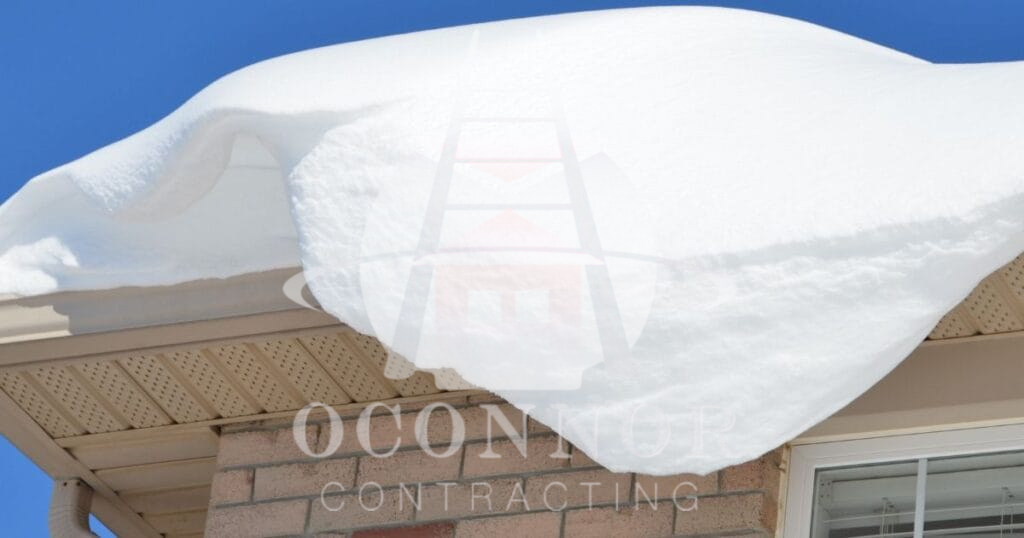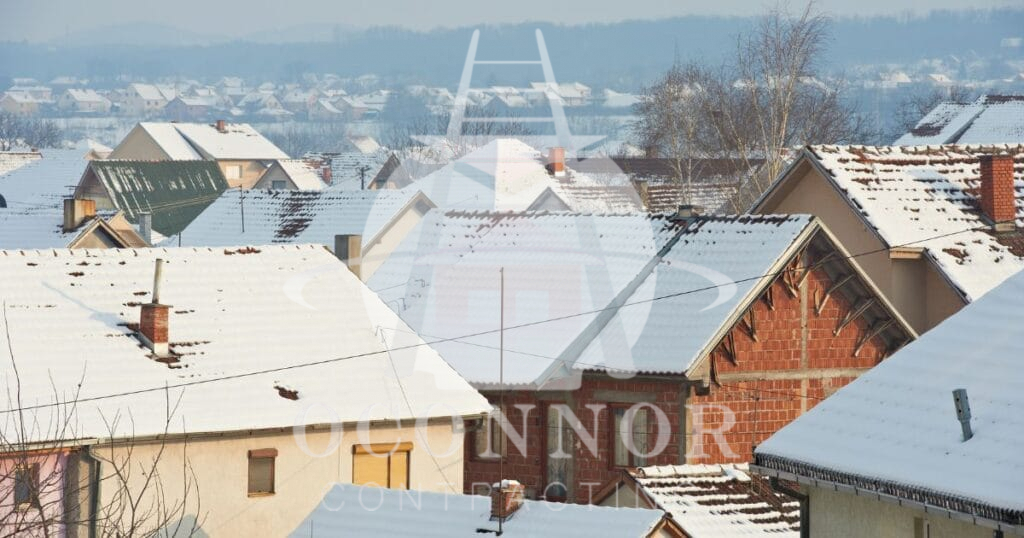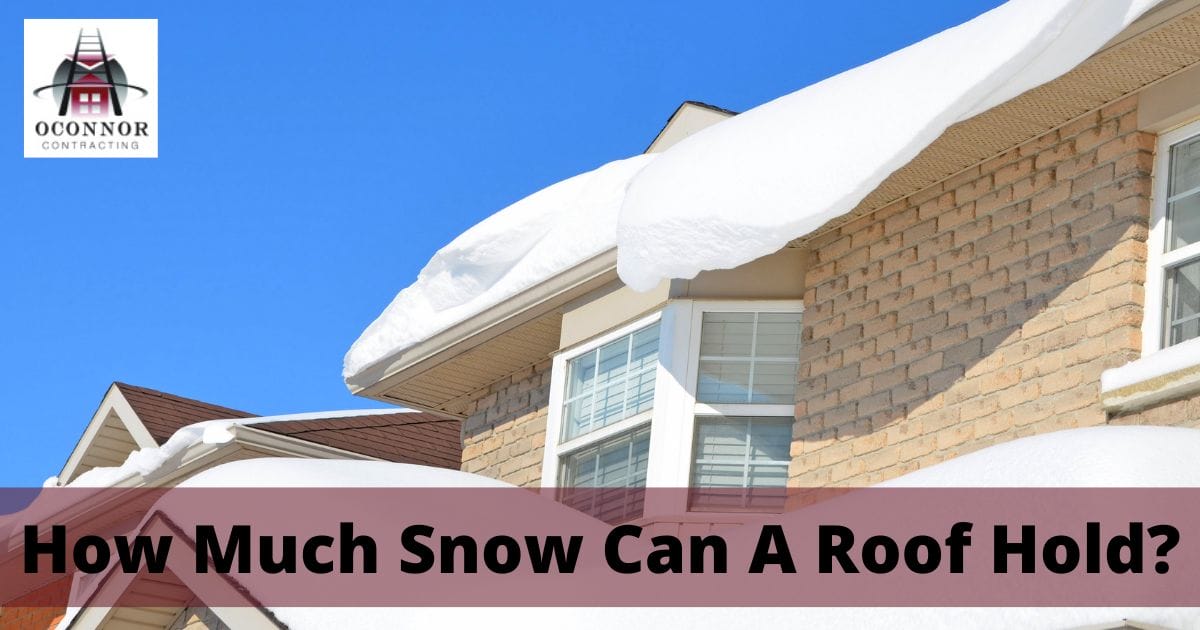Winter brings plenty of challenges for homeowners, and the roof is no exception. While we’re all familiar with common winter roofing issues such as ice dams, leaks, and icicles, there’s another concern that often goes overlooked – the weight of snow on your roof. In this blog post, we’ll delve into the question of how much snow can a roof hold, before it poses a risk? It’s essential to understand this to ensure your home’s safety and prevent potential structural problems during the winter months.
How Much Snow a Roof Can Hold
It’s important to ensure that your roof’s snow load capacity is not compromised during the winter months in order to maintain the safety and integrity of your home.
The snow load capacity of a roof is based on various factors, all of which ultimately determine how much snow it can safely bear. Here are the key aspects that influence a roof’s snow-holding capabilities:
- The Snow’s Weight: The quantity and density of the snow that’s accumulated on your roof is a primary factor. Heavier, wet snow exerts more pressure than lighter, fluffy snow.
- Roof Design: The architectural design of your roof plays a critical role in its snow load capacity. The pitch or slope of the roof can either help shed snow or trap it, affecting the overall load.
- Roofing Material: The type of material your roof is constructed from matters significantly. Different materials have varying levels of resistance to snow. Some are more durable and less likely to succumb to heavy snow loads.
Understanding how these factors come together is essential to safeguarding your home from potential snow-related issues. It’s important to assess your roof’s capacity for handling the typical snowfall in your area, particularly considering snow type and density. Additionally, regular maintenance and vigilance during heavy snowfall can help ensure your roof remains secure, preventing potential damage and costly repairs.
Measuring The Weight Of Snow On Your Home
Measuring the weight of snow on your home is essential for understanding the pressure your roof may have to withstand during winter. The weight of snow and ice, typically measured in pounds per square foot, determines this pressure. Light snow exerts 5 to 20 pounds per square foot, while snow packs, usually made of wet, denser snow, increase the weight to 20 to 40 pounds per square foot. If you’re dealing with a packed snow and ice load, the weight may reach 40 to 58 pounds per square foot, with pure ice exerting around 58 pounds per square foot.
Also read: 9 Types of Snow Guards for Metal Roofs & How to Choose One

Understanding Your Region’s Snowfall Patterns
In regions across the United States, the amount of snowfall can vary significantly, so knowing your local snowfall pattern is essential when considering the potential weight of snow on your roof. This knowledge is particularly important if you reside in areas that are accustomed to a substantial amount of snowfall.
- Buffalo, New York: An Annual Snowfall Overview
- Buffalo, New York, typically experiences an annual average snowfall of around 68.8 inches.
- Snowfall occurs from November to April, with occasional early snow in October.
- Snow-free months in Buffalo are typically from May to September.
- Daily Snowfall Patterns
- On most days, snowfall results in less than an inch of accumulation.
- An average of 26 days each year sees at least an inch of new snow.
- Frequent snowfall occurs throughout the winter season.
- Snowstorms in Buffalo
- Buffalo encounters around four snowstorms a year with over five inches of snow in a single day annually.
- Major blizzards, depositing 10 inches or more, occur about once a year.
Understanding these local snowfall patterns enables you to prepare for potential snow loads on your roof. By knowing what to expect, you can take necessary precautions to ensure your home remains safe and secure during the winter months.
How To Safely Remove Snow From A Roof
Safely removing snow from your roof is essential to prevent potential issues like ice dams and structural damage. To do this without risking harm to your roofing material, follow these steps:
- Assess the Situation: Before tackling snow removal, carefully evaluate the snow amount and roof slope. For steep roofs, it’s best to hire a professional to handle it.
- Gather the Right Tools: Equip yourself with the necessary tools, like a roof rake with a long handle to remove snow without stepping on the roof.
- Check for Ice Dams: Before clearing the snow, look for ice dams that can cause leaks. If found, consult a roofer for safe removal.
- Clear from the Edges: Begin by clearing the roof’s edges, working your way inward to prevent snow from sliding off and causing damage.
- Use a Roof Rake from the Ground: The safest method is to remove snow from the ground using a roof rake. Position it at the roof’s edge and pull snow down.
- Leave a Thin Layer of Snow: Don’t remove all the snow; a thin layer provides insulation and protection from moisture damage.
- Take Breaks and Dress Warmly: Snow removal is physically demanding. Take frequent breaks and dress warmly to avoid hypothermia and frostbite.
- Watch for Power Lines: Be cautious of overhead power lines; never use a tool that could touch them.
- Consider Professional Help: If you’re uncomfortable or lack skills, hire a professional roofing company for challenging snow removal tasks.
By following these steps, you can safely clear snow from your roof and protect your home from potential winter hazards.
Also read: Top 3 Roof Rakes for Snow: A Comparative Review

Warning Signs Of A Weak Roof
Warning signs of a weak roof can often be tied to its snow load capacity. When it comes to assessing the health of your roof during winter, considering how much snow a roof can handle is crucial. Here are some key indicators to look out for:
- Sagging or Dipping: One of the most apparent signs of a weak roof is when it starts to sag or dip in the middle. This could be a clear indication that it’s struggling to support the snow’s weight.
- Interior Leaks: If you notice water stains or leaks on your ceiling or walls, it might be because your roof’s snow load capacity has been exceeded. Melting snow can find its way through these weakened spots.
- Cracked or Split Roofing Material: Check your roof for any visible damage, like cracked shingles or split roofing material. Snow accumulation can put stress on your roof, leading to such issues.
- Bowing or Bent Rafters: Inside your attic, inspect the rafters. If you see signs of bending or bowing, it’s a clear sign that your roof is struggling to bear the snow’s weight.
- Excessive Icicles: Large icicles hanging from your roof’s edge may indicate an issue with melting snow not properly draining off, which can lead to excess weight.
Prepare Your Roof For Winter With OConner Contracting
Understanding how much snow a roof can hold is essential for safeguarding your home during the winter months. It depends on various factors, including the type of snow, the roof’s slope, and roofing material. By being aware of these considerations and taking appropriate precautions, you can ensure that your roof remains strong and secure, even when the snow starts to pile up.
If you want to assess your roof and ensure that it will be able to withstand the upcoming winter weather, just contact the team at OConner Contracting. We’ve been serving Buffalo, and the surrounding area for years, and know how the winter weather around here affects the homes in our community. Give us a call today at (716)-600-7663 , and one of our professionals will come out to your home to inspect your roof and ensure it’s ready for winter. Plus, if we find anything notable, we can offer you great prices on repairs!


